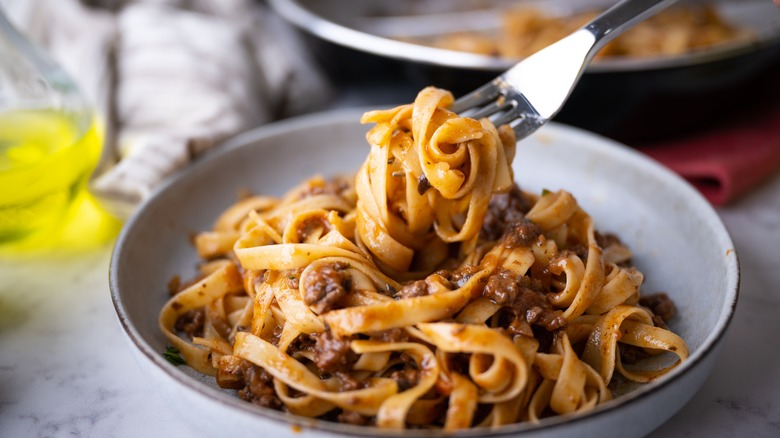Does The Shape Of Pasta Impact Its Taste?
If Shakespeare had been an Italian chef, he inevitably would have pondered if a noodle of any shape would still taste as delicious. Whether or not the cut of pasta changes its flavor isn't something that most people think about, but many noodle lovers have a go-to pasta preference depending on the dish. There may be a reason you've likely never tucked into a bowl of spaghetti and cheese (instead of mac and cheese), leaving us in carb-loaded contemplation over the effect of pasta shape on flavor.
Auguste Escoffier School of Culinary Arts' chief academic officer and corporate executive chef Miles Mitchell told Eat This, Not That! it's not the cut of the pasta that changes the taste, but rather the ingredients that go into a particular pasta and the sauce paired with it. Different kinds of pasta are made with a variety of flours, from the buckwheat flour in soba noodles to the semolina used to make traditional wheat-based pasta, and each flour carries a signature flavor. Fresh pasta is often made with eggs, differentiating its flavor from that of simple wheat and water-based noodles.
The Cooking Academy argues that different cuts of pasta can affect the flavor of a final dish by changing the complexity of the other ingredients in the dish. Choosing the right type of pasta might make or break your meal, and there are a few flavor factors to consider before your next carb-loading session.
Size matters
The cut and texture of different pasta hold sauce and condiments differently, and The Cooking Academy correlates this with the overall flavor of a dish. Long and narrow cuts of pasta like spaghetti and linguini pair well with lighter sauces like a cacio e pepe or thin tomato sauce that coats the noodle easily. When you have a thicker sauce like a bolognese or a chunky ragu, you'll want to bust out the big cuts like a pappardelle or tagliatelle; a larger noodle's ability to catch all those big bits of goodness in the sauce translates to big flavor on the plate.
When working with small cuts, heartier sauces taste better with textured rigatoni or rotini, as those provide nooks and crannies for chunkier bits. Smooth, short pasta cuts like macaroni and ziti feature the flavor of thinner cheese sauces and pestos better. When it comes to sauce and toppings, there's a flavorful match for each pasta shape. The shape of the pasta directly compliments the sauce, carrying more flavor to your mouth and leaving less in the bowl.
Even with the sauce on the side, Del Villaggio notes that the size and shape of a noodle can change the way it tastes. A thicker, more substantial noodle with a larger surface area will carry a more intense grain flavor, lending a richer, creamier texture and flavor to its dish. A thinner, smoother pasta cut will taste different, as its size features a lighter, less intense starchy flavor.

